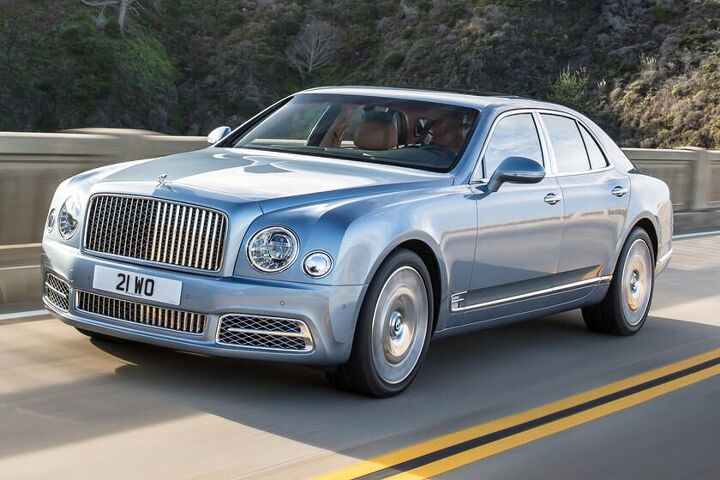#V8Engines
Junkyard Find: 2006 Buick Lucerne CXS
Remember, not many years ago, when American car shoppers could choose among dozens of new Detroit sedans? For the 2006 model year alone, General Motors offered 12 different four-door sedans, and that’s ignoring sub-models plus the sedans bearing the badges of (GM-owned) Saab and Suzuki. Today, there are three new GM sedans available here, and both of the Cadillacs are built on the same platform as the Camaro. The Buick Division got out of the US-market sedan game when the final 2020 Regal rolled off Opel’s line in Rüsselsheim, but the very last proper full-sized Buick sedan was Hamtramck’s own Lucerne. I found this Northstar-equipped first-year Lucurne in a Colorado Springs yard last month.
In Memoriam: The Rolls-Royce-Bentley Six and Three-Quarter Litre V8
Today we bid a belated farewell to a legend of an engine, the Six and Three-Quarter Litre V8. In production since 1959 at the factory in Crewe, The L-series V8 had several different displacements and powered many different luxury vehicles. And some boats.
7 Reasons Why the Lexus IS 500 is the Perfect Car for Driving Enthusiasts
The Lexus IS 500 isn’t just an exciting new sports sedan, it’s a unicorn. That’s because when Lexus first decided to put the IS 500 into production, they relied on a simple philosophy: put a big engine in a small car, and make it go really fast. But this car is so much more than just a beefed-up IS.
Here are 7 key reasons why the Lexus IS 500 is sure to appeal to automotive purists.
Shrinking F-150 V8 Demand Prompts Shift Cut at Ford Engine Plant
Americans love their Ford F-150s, but buyers are increasingly opting for a powerplant boasting fewer than eight cylinders. As such, the automaker is cutting the third shift at the Windsor, Ontario engine plant tasked with building the 5.0-liter Coyote V8.
Ford V8s and Windsor have a long association, but the extraneous employees needn’t worry about hitting the job boards. There’s a much larger V8 in need of assembly.
Buy/Drive/Burn: Big German Luxury Sedans of 1991
They’re large, expensive, and hail from a time when the sedan was king of the luxury pyramid. German exclusivity personified in three flagships — but which will you burn?
Electric Cars Are Nice, but Audi Customers Still Demand V8s
Did you hear the news? Every automaker worth its salt will switch to electrified, fully autonomous vehicles yesterday.
Bored yet? Very likely so, but the people laying out money for cars still have a say in what vehicles automakers produce, and for high-end buyers, prestige doesn’t necessarily come wrapped in the latest technology from the pages of Wired. Big-money buyers want big power and, while that increasingly means the latest in twin-turbocharged, downsized wonderengines, it isn’t always so.
Audi can’t wait to challenge Mercedes-Benz, BMW, and Jaguar in the premium electric car race, but there’s no way its customers would agree to the disappearance of a proper eight-cylinder gasoline engine, claims the brand’s technical development chief.
Sorry, Mopar Fans: FCA Says 'No' to a 2019 Chrysler 300 Hellcat
If you’ve got it, flaunt it. Go ahead and shake your money maker.
Or not.
After reports surfaced at Automotive News earlier this week that the 707-horsepower supercharged 6.2-liter V8 from the Dodge Charger Hellcat, Dodge Challenger Hellcat, and Jeep Grand Cherokee Trackhawk would appear in a Chrysler 300 next year, Motor Authority has heard from Fiat Chrysler Automobiles on the subject.
It’s not going to happen.
At Mercedes-Benz, There Remain Instances in Which There's No Replacement for Displacement
Want a six-cylinder engine?
Don’t buy a two-door Mercedes-Benz S-Class.
For the 2018 model year, Mercedes-Benz will offer a S450 sedan with a twin-turbocharged 3.0-liter V6. It’s not underpowered. 362 horsepower produce a claimed 0-60 miles per hour time of 5.1 seconds.
But sometimes, every now and then, in a handful of remaining instances, Mercedes-Benz evidently believes there is no replacement for displacement. The Mercedes-Benz S-Class coupe and cabriolet?
V8s and V12s only, thank you very much.
Ford F-150's V8 Market Share Shrinks to Just a Quarter
As Ford prepares to launch the refreshed 2018 F-150 with a thoroughly updated engine lineup, Blue Oval product planners expect 2017’s engine selection to continue. That means the 5.0-liter V8, while mildly upgraded for 2018, will be found under the hood of only one in four 2018 F-150s.
The transition has been a rapid one. Twin-turbocharged EcoBoost V6s were surprisingly effective when, in early 2011, 35 percent of F-150 buyers made the leap from conventional naturally aspirated powerplants. Three years later, when Ford was planning to expand the F-150’s EcoBoost lineup with a less costly 2.7-liter variant, Ford expected 56 percent of F-150 buyers to choose one of the turbocharged units.
Heading into 2018, Ford’s truck marketing manager Todd Eckert tells Automotive News that the 2.7-liter EcoBoost will be the most popular F-150 engine followed by the 3.5-liter EcoBoost. Together, they’ll claim 65 percent of all F-150 sales, leaving 10 percent for the new entry-level 3.3-liter, and roughly 25 percent for the five-point-oh.
So how many V8 engines is that?
The V8 Engine Has a Future After All, Says Jaguar's Design Head
Ian Callum, the director of design at Jaguar, spoke recently at Coventry University’s National Transport Design Centre on various subjects related to the auto industry.
Callum, a Coventry University alumnus, touched on automotive history, autonomous vehicles, the buying process, even Jaguar itself.
Ian Callum also had something to say about the V8 engine, according to CAR Magazine.
Long live the Queen.
Long live the V8.

























Recent Comments